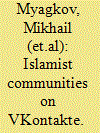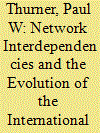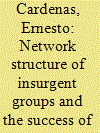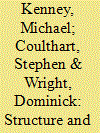| Srl | Item |
| 1 |
ID:
172243


|
|
|
|
|
| Summary/Abstract |
This article examines the presence of extremist online communities on the Russian social network VKontakte following the tightening by Russian federal аuthorities of internet counter-extremism policies and censorship. Extremist communities were detected using linguistic markers for extremist attitudes and radical violence. The study of socio-demographic data and network metrics of Islamist extremist communities reveals some general tendencies in the Russian context: a majority of female participants, a highly decentralised community network structure, radical Salafism as the mainstream ideology and covert proselytisation through the discussion of Islamic theology and lifestyle issues that are not in themselves extremist.
|
|
|
|
|
|
|
|
|
|
|
|
|
|
|
|
| 2 |
ID:
094734


|
|
|
|
|
| Publication |
2010.
|
| Summary/Abstract |
The authors analyze the optimal network structure of two types of terrorist organizations. In the centralized network, the leadership selects the level of individual effort and the level of group connectivity so as to maximize the expected net welfare of the organization's membership. Leaders in loosely connected networks will also seek to balance the trade-off between security and communications. However, with decentralized decision making, the individual nodes may not make optimal decisions from the group's perspective. As a consequence, the decentralized decision-making process is suboptimal from the overall perspective of the network. In particular, the leadership in a centralized network is able to coordinate the activities of all network members and to take advantage of important network externalities.
|
|
|
|
|
|
|
|
|
|
|
|
|
|
|
|
| 3 |
ID:
167382


|
|
|
|
|
| Summary/Abstract |
Since few states are able to produce all of their own military hardware, a majority of countries’ military systems rely on weapon imports. The structure of the international defense technology exchange network remains an important puzzle to understand, along with the factors that drive its evolution. Drawing on a political economy model of arms supply, we propose a new network-oriented explanation for the worldwide transactions of major conventional weapons in the period after World War II. Using temporal exponential random graph models, our dynamic approach illustrates how network dependencies and the relative weighting of economic versus security considerations vary over time. One of our major results is to demonstrate how security considerations started regaining importance over economic ones after 2001. Additionally, our model exhibits strong out-of-sample predictive performance, with network dependencies contributing to model improvement especially after the Cold War.
|
|
|
|
|
|
|
|
|
|
|
|
|
|
|
|
| 4 |
ID:
160877


|
|
|
|
|
| Summary/Abstract |
We argue that organizational structure of insurgent organizations influences the prospects for success in a disarmament, demobilization, and reintegration process (DDR). In essence, we argue that more cohesive, tighter networks have higher levels of supervision and control on its military units and increase the probability of successful DDR processes. In order to evaluate our hypotheses, we use the theory of networks to map and characterize the network structure of the United Self-Defense Forces of Colombia (AUC) and the Revolutionary Armed Forces of Colombia (FARC). Our results suggest that armed military units grouped in smaller and more isolated components on the network remilitarize with higher probability with respect to other units on the network. Also, we find that military units with high degree of centrality on the network play an important role for the risk of conflict recurrence and success in a DDR process.
|
|
|
|
|
|
|
|
|
|
|
|
|
|
|
|
| 5 |
ID:
077067


|
|
|
|
|
| Publication |
2007.
|
| Summary/Abstract |
After the events of 9/11, U.S. counterterrorism became more proactive in that the Patriot Act allowed the authorities far more freedom to directly attack terrorist network structures. We argue that rational terrorists will attempt to thwart such policies and restructure themselves to be less penetrable. We model the trade-off between security and intragroup communication faced by terrorists. The model is used to derive the anticipated changes in network structure and the consequent changes in the type, complexity, and success rate of potential terrorist attacks.
|
|
|
|
|
|
|
|
|
|
|
|
|
|
|
|
| 6 |
ID:
156540


|
|
|
|
|
| Summary/Abstract |
This study combines network science and ethnography to explore how al-Muhajiroun, a banned Islamist network, continued its high-risk activism despite being targeted for disruption by British authorities. We analyze news reports, interviews, and field notes using social network analysis and qualitative content analysis to test hypotheses pertaining to network structure and performance. Our analysis suggests that the activist network’s structural properties had important implications for its performance during three separate time periods. What began as a centralized, scale-free-like, small-world network centered on a charismatic leader evolved into a more decentralized “small-world-like” network featuring clusters of local activists connected through multiple bridges. This structure allowed the activist network to engage in contentious politics even as its environment became increasingly hostile. We conclude by discussing the implications of al-Muhajiroun’s small-world solution for scholars and policy makers.
|
|
|
|
|
|
|
|
|
|
|
|
|
|
|
|